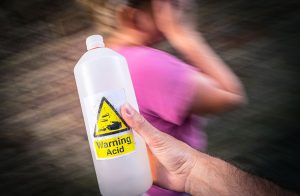Posted on September 1, 2017
By Dr. Christina Baxter, Emergency Response TIPS, LLC
Posted on December 4, 2017
 According to the American Foundation for Suicide Prevention, suicide is the 10th leading cause of death in the United States with greater than 44,000 deaths and 1.1 million suicide attempts annually. This results in an annual age-adjusted suicide rate of 13.26 suicides per 100,000 individuals or 121 suicides per day. These rates have been a slow increase for the past ten years. Despite the common myths suggesting the December Holiday season as the peak rate of suicide deaths, the opposite is true. Data from the Center for Disease Control and Prevention and the National Center for Health Statistics collected over the past four decades show that suicide rates are lowest during the winter months and highest during the early spring (April and May). While firearms remain the most common method of death by suicide, poisoning accounts for 15% of the deaths.
According to the American Foundation for Suicide Prevention, suicide is the 10th leading cause of death in the United States with greater than 44,000 deaths and 1.1 million suicide attempts annually. This results in an annual age-adjusted suicide rate of 13.26 suicides per 100,000 individuals or 121 suicides per day. These rates have been a slow increase for the past ten years. Despite the common myths suggesting the December Holiday season as the peak rate of suicide deaths, the opposite is true. Data from the Center for Disease Control and Prevention and the National Center for Health Statistics collected over the past four decades show that suicide rates are lowest during the winter months and highest during the early spring (April and May). While firearms remain the most common method of death by suicide, poisoning accounts for 15% of the deaths.
While chemicals have been used for suicides throughout history, it is only since the advent of the internet that chemical suicides methods have evolved and become more common. While the total volume of these types of deaths is still relatively low worldwide, the threat to the safety of emergency responders and bystanders is significant as the gases are produced using readily available materials and are often carried out in vehicles, bathrooms, and hotel rooms. Detailed information and how-to-guides are readily available on assisted suicide websites. The most common methods of chemical suicides involve the production of hydrogen sulfide, hydrogen cyanide, phosphine, or carbon monoxide gases.
 The metal sulfide route to generate hydrogen sulfide, often called “detergent suicide.” was widely used in Japan for chemical suicides. In the U.S., the bath sulfur is often replaced with sulfur-based insecticide or dandruff shampoos. The sulfur source is mixed with an acid such as hydrochloric acid to generate the hydrogen sulfide.
The metal sulfide route to generate hydrogen sulfide, often called “detergent suicide.” was widely used in Japan for chemical suicides. In the U.S., the bath sulfur is often replaced with sulfur-based insecticide or dandruff shampoos. The sulfur source is mixed with an acid such as hydrochloric acid to generate the hydrogen sulfide.
Hydrogen cyanide suicides have taken two different approaches using the same chemical reaction. Most commonly, the person directly ingests the metal cyanide, and it reacts with the stomach acid to generate hydrogen cyanide. Alternatively, this has also been done by mixing in a container and allowing the gas to form within an enclosed space.
The production of carbon monoxide by mixing formic acid and sulfuric acid has been promulgated by the “Peaceful Pill Handbook” and “The Complete Manual of Suicide.”
Based upon the reagent quantities suggested in suicide handbooks and websites, hydrogen cyanide and phosphine concentrations tended to be lowest thereby posing toxicity hazards but not a flammability hazard. Hydrogen sulfide posed a toxicity hazard and, in some cases, the concentration exceed 10% of the lower flammability limit. Therefore, the flammability hazard must be monitored for hydrogen sulfide methods. The carbon monoxide levels generated were the highest of all the methods evaluated and approached the lower flammability limit in small enclosed spaces, such as cars. Therefore, flammability cannot be discounted.




Emergency Response Guidance
- Emergency responders need to isolate the affected area and not enter the space without first considering the hazards and risks.
- The environment should be continuously monitored for toxicity and flammability using portable gas detection equipment over a range from below the permissible exposure limit (PEL) up the lower flammability limit (LFL) and including the immediately dangerous to life and health (IDLH) level and the lethal concentration (LClo).
- In the majority of situations, the PEL and IDLH levels will be exceeded, therefore Self-Contained Breathing Apparatus is required.
- Hydrogen sulfide, hydrogen cyanide, phosphine, and carbon monoxide have been determined to not be skin hazards at the concentrations up to, and including, lethal concentrations; therefore, firefighter protective gear is suitable for skin protection.
- Fresh Air Decontamination can be performed through natural ventilation or forced ventilation. If the toxic or corrosive liquids/solids come into contact with a person or the toxic reagents have been vomited, wet decontamination approaches are warranted.
For further information, see our article in the May/June 2017 issue of the Journal of Chemical Health & Safety.
Tools for Consideration
Detection:
- Four Gas with PID Detectors (Rae Systems MultiRAE Family or MSA Altair 5X PID)
- Raman (Thermo Fisher First Defender RMX or Cobalt Light Resolve)
- Colorimetric Tubes (Draeger Tubes)
- Flame Photometry (Proengin AP4C)
- AirBoss ISOPOD
Protection:
- SCBA (Scott Safety Air-Pak X3 SCBA or MSA G1 SCBA)
Decontamination:
- First Line Technology (Dahlgren Decon and Fibertect Wipes)
Medical:
- Meridian Medical Technologies (Cyanokit)
Dr. Christina Baxter is the CEO of Emergency Response TIPS, LLC which provides practical, evidence-based solutions for emergency response through the development of next-generation tools for enhanced situational awareness and responder safety and instructional design materials for instructor-led and web-based programs in the areas of CBRNE, hazardous materials, and clandestine laboratory response.

